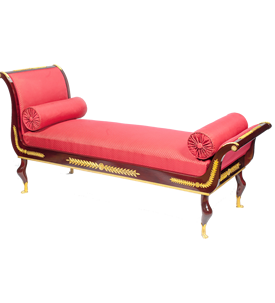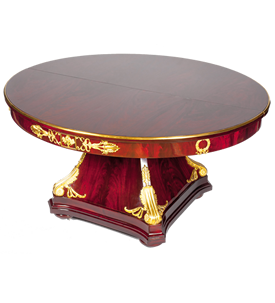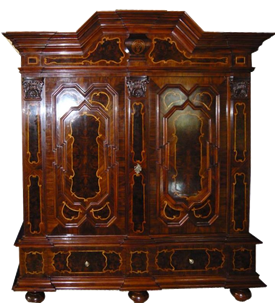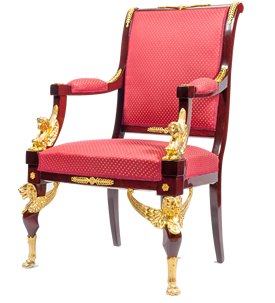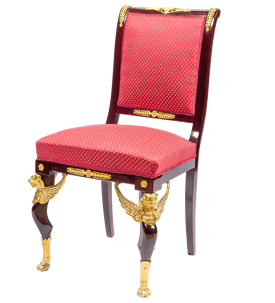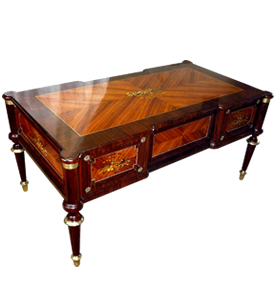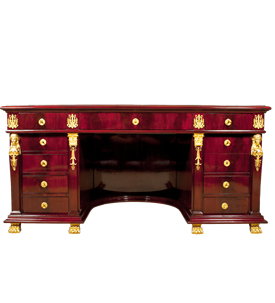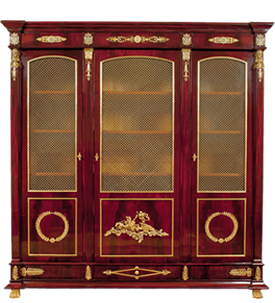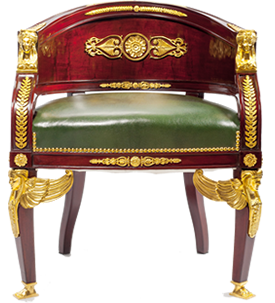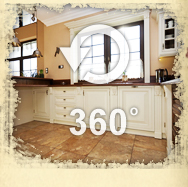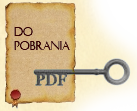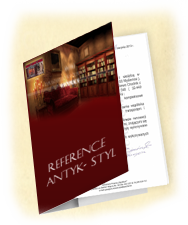English style – is the perfect combination of tradition, comfort and harmony with the environment, referring to the furniture from the era of Louis XVI. Furniture in the English style is characterized with not ordinary working life and high quality of creation. It is made of solid wood, excellent quality, mostly mahogany, walnut and oak. Each piece is a true work of art, because of the non – factory way of creation. All the work is done by hand, decorated with rich stucco-wooden carvings, numerous cornices, pilasters and floral motifs - acanthus leaves, lion's heads and other figural motifs. English-style furniture is often in the cream and white color.
Kitchens in the English style are perfectly combined with household appliances such as dishwashers, hoods, refrigerators and kitchen inductive. A characteristic feature of all the English kitchens is an island kitchen with a thick marble tabletop and numerous drawers and shelves for small items and wine. Dressers made in the English style can be recognized by the glass cabinets, with gold stylish "age" handles, with numerous beautiful porcelain. Hoods and stoves in the English style are always built, solid, with carved floral highlights and small columns.
Floral patterns occur not only in furniture finishes, but also on upholstery or curtains. Hunting paintings, innumerable tables, cabinets and dressers and sofas with soft, velor upholsteries - characteristic of the English style. The furniture is created for people who want warm, stylish interiors with a touch of nostalgia.
Applicator – it is a separately executed ornament, which is then attached to a piece of furniture and creates an integrated whole.
Angelote (Spanish) - is a type of rich decorative carving, depicting floral motifs, animal, human characters such as chubby children. This decoration was primarily a folk character.
Arabesque - derives from the Arabic art, it is an ornament in the form of a plant flagella, often complemented by geometric shapes, arms, human figures, or fruit. Arabesque is used in friezes, plinths and other items of furniture.
Arte Povera (Italian) - the technique of decorating furniture, consisting of firming the surface of furniture, printed sheets of paper depicting human figures. The prepared surfaces with several layers of varnishing a transparent resin, to achieve an adequate gloss. Arte Povera is a very fast and cheap method of decorating furniture.
Atlant – is a support in the form of a statue of a man, remains an architectural element such as a ceiling, or a balcony from antiquity.
Art deco - this period is counted from approximately 1918 to 1940. Its principal features in furniture, flowing lines are derived from abstract art. Art Deco was established in France, is an interesting phenomenon because it brings together various strands, the first time it was a design with a view of a particular piece of furniture.
Furniture used in the construction of such mahogany, maple, ash, rosewood, ebony as a veneer. Furniture was finished with lacquer, applied marquetry, and the most sophisticated exhibits were coated with a shark or snake skin. This style is the use of expensive materials, gained a reputation as a luxury.
Stain – dyed fabrics, serving items made of wood, especially hardwood.
Stain penetrates well into the structure of wood, stained the surface while leaving the grain visible. It works perfectly if you want to align the color of the substrate, masks borders combine several elements of different shades or have defects on the surface. To dye stains, furniture surface should be smooth, well free from dust, while the humidity should be about 8%.
Barocco – (in Portuguese barocco means - the irregular surface of the pearl). The beginning is taken at the end of the sixteenth century. The new direction was born in Italy, but soon gained adherents in the north. Baroque was flourishing at the court of Louis XIV at Versailles, hence spread to Europe.
The new style was characterized by the pomp, curved line and the full expression of movement.
Baroque is primarily abundance, wealth, gold decorations, theatricality, fine, heavy style, exquisite sculptures, asymmetry, and plant and animal ornaments in the frequently used items such aslion's paws, swans, eagles, and cornucopias.
Cabriolet – the concept of defining the concave back of the chair or the chair, which "wraps the back seat”. Since the eighteenth century, found in stores, preserved as an important element of contemporary furniture.
Cyclin - (or plaice) - a tool for manual wood smoothing.
Four-leaf – one of the most popular plant motifs in the Romanesque style and the Gothic style. It creates contours of the shape of four petals. Often found in the heads, stone balustrades and ornaments in the windows.
Cassapanca - (chest - bench) - is a piece of furniture used to seat, evolved from the box with the name Cassone, to which there was added a back, and handrails. Cassapance is decorated with an inlay and inlaid with ivory.
Confidant (French) - (or assemblage) – a couch from France, consisting of two single seats.
After applying the formula for the item, we cover it to 30-40 layers of varnish that is completely melted and it was not perceptible to the touch.
Three layers of natural wood, combined with organic glue joint are among the highest quality flooring.
Excellent thermal and acoustic insulation, extremely resistant to strain and mechanical damage. With the hygroscopicity of wood has the natural regulation of the microclimate of the interior where it is installed. All the components used to manufacture meet the strictest environmental standards.
Barlinek floorboard is ideal for bedrooms, children rooms and nurseries.
Exotic wood (imported from Africa, Asia or South America) - is highly valued in our market, especially because of the magnificent, unusual grain, color and smell. It has excellent properties of both physical and mechanical properties such as hardness, stability with humidity changes.
Application: floors and stairs, veneer, interior joinery.
Application: veneer - to produce high quality furniture
3. DOUSSIE - (Africa), has a precious honey color, it is a stable wood, the content of fatty substances in the wood enhances its natural durability, is resistant, moderately resistant to external factors.
Application: windows, doors, parquet flooring, veneer, laboratory tables.
Application: flooring, furniture, woodwork.
5. IPE - (South America), brownish-black color, it has a very high mechanical resistance - high resistance to wear, difficult to dry and hard to work with.
Application: floor - especially in public buildings, carpentry, machine handles.
Application: parquet and flooring, veneer, furniture.
7. SAPELLI - (Africa including Ghana, Uganda, Zaire), an intense bright red color and red-brown striped wood, very easy to process with.
Application: furniture, flooring, veneer, stairs, and interior trim panels, production of high quality furniture.
8. TEAK - (South - East Asia) color dark brown with distinct veins, very resistant to insects, no warps, and does not swell, very good for any machining - turning, grinding and polishing.
Application: furniture, flooring, interior and exterior windows and doors.
9. WENGE - (comes from Central Africa, Cameroon, Gabon, Congo, Zaire), dark brown with purple-black rings, wood easy to work with. High resistance to abrasion, in addition to the dark surface shows no evidence of any contamination. Another advantage of this truly exotic wood is a naturally high durability.
Application: veneer and furniture.
Decoupir - it is a transparent (cut) ornament or decoration of furniture.
Dante chair - scissors armchair, its uniqueness lies in the arrangement of the legs - a shape of the letter X. The curved legs combine with handrails, and the whole back seat is often made of fabric or leather, which are mounted with the help of straps.
Dresuar (or buffet, bas d'armoire, buffet à pans coupes) - This is a dresser already known from the Middle Ages, it is used for storage and display of rich vessels. Dresuar is a representative piece of furniture, an open bottom, set staggered shelves. It is used mainly to decorate the hall room, it is the wealth of the landlord.
Dumb-waiter - a small table with three tops, oval-shaped, conically arranged along a single system. Richly contoured, supported on a tripod. The most common in the UK since the mid-eighteenth century.
Whatnot - (Franch. Étagère - bookcase) - a lightweight, handheld, portable, outdoor, wall shelf, composed of several plates, one under the other. In Polish there is a distinction between shelf and bookcase. In French, "étagère" means both rack and shelving.
Ebonist – a carpenter specializing in the creation of numerous ornate inlaid furniture, inlaid and ebony veneer. The name comes from ebony, most commonly used wood.
Empire - raw style, with a simple form, which was originated in France around 1804-1815, the element which was in virtually every piece of furniture, was the letter "N" in a laurel wreath. Empire lether is a reference to the art of ancient Rome and Greece, used to celebrate the victories of governments and Napoleon.
In the Empire style there dominated plain and simple planes and lines, the furniture, however, rarely has smooth legs, inserted in their place the supports in the shape of a female sphinxes, swans and lions. Common themes were repeated including winged figures of ancient goddesses, muses in all its glory or bust and head, rod lictory, swans, garlands, acanthus leaves, palm leaves, vases, cornucopias.
The prepared stump of a tree, it will be subjected for cutting into thin sheets, then the behavior of the same order are combined in a bundle. This is very important because we keep drawing jars and continuous tones. Sheet thickness ranges from 0.1 to 5 mm.
The most common veneers:
- beech,
- alder,
- birch,
- ash,
- clone
- pine,
- walnut
- exotic: Sapelli, Anger, Padouk
The last step is just the transverse cutting into sheets – veneers. That created a mapping of veneers obtained using traditional and at the same full warranty on the reproducibility of the veneer and color inherent to the deliveries made, even in large intervals.
The most popular veneers on the Polish market are:
- beech,
- white oak,
- wenge,
- ebony,
- redpoll,
- chessboard
- collected,
- nuts,
- cherry,
- rosewood.
Faldstool - a chair or stool with crossed legs. Found in early Middle Ages, mostly in churches and courts. Made of iron, bronze or wood, often ended with lion paws, and carved railings adorn the head of the animals.
Used in ancient times, the falls of the seventeenth century renaissance, but already in the eighteenth almost entirely supplanted by the marquetry.
Geridon - its origins to the middle of the seventeenth century in France. A small, neat, round table, on one leg, perfect for delay things. Gained great popularity during the Rococo. Geridon can also be found on three or more legs in the shape of mythological characters, Egyptian, or African.
Head - an element of construction - decorative, the top of the column, pillar, combined with supporting elements. The head according to the country or the era took a variety of themes, including
Egyptian heads (often vegetable form):
- Heads of palm,
- Lotus,
- Papyrus (a variety of packing and Chalice)
- Hathoric heads (the head of the goddess Hathor),
- Heraldic (theme lilies and papyrus), so called. protodoric.
In ancient Greece we distinguish types: Doric, Ionic, Corinthian.
In ancient Rome used more head - Tuscan and Composite.
Cornice is available in different forms:
- Antiquity - the most advanced in the arts received the Greek
- Ages introduced the simple form strongly undercut the small faults;
- Took the form of the classical revival,
- Mannerism and Baroque shaped cornice richly
Galba (French.) - kind of slightly bent legs.
Balustrade - a repeated ornament, usually transparent, ending the top of the furniture.
Dressing (from French. Garde-robe) - a room intended for storage of clothing.
Gothic seats, based upon the boxes, to which there was added back and side rails. Gothic beds consisted of a part of the chest and the canopy, while the lateral plane were covered with floral ornaments. Tables in the Gothic gained a new look, top plate was supported by two simple or fancy bucks, there are tables on the basis of the box with a sliding plate or open on hinges. The surfaces of the sides of the tables decorated with coats of arms of the owners.
In the late Gothic period there have developed two-and four-wing cabinets. In addition, there are cabinets with a few small door at the top and bottom, and between them was placed a small drawer and flap closure. Gothic brought us a well-known closet today. These cabinets have only a front split into many parts of unequal parts.
- early (approx. 1715-1740) - with architectural features;
- mature (1740 - 1760) - light, asymmetrical rococo;
- late (after 1760.) - Rigid classicist.
Recurring themes in the Georgian style were carved eagles, masks, Chinese, and musical themes.
Is also encountered a variety of dark ebony color with black wood grain or figure with a gray spotted.
Inlay - a technique of decorating furniture and works of art, known and used since antiquity. It consists of decorating the surface of furniture, including cut tiles of ivory, wood, metal, pearl, colored stones, gold and silver.
The plates are placed in a specially pre-prepared cavities, in the form of figures, plants, ornaments and geometric shapes. The flourishing of this technique is the seventeenth - eighteenth century in France. Most decorative inlaid chest, wardrobes, tables, desks, pulpits, doors and paneling.
Marquetry - (On intarsio - carpeting) - this term means a technique of decorative, consisting formed by lining the surface of objects with wooden tiles (especially furniture) other species of wood, often colored, stained, tan, resulting in a color pattern. A model put in place to remove fragments from the surface of the furniture. Marquetry was used in ancient times, and the Baroque and Renaissance eras were the best. The oldest object is a sarcophagus with cedar from about 2000 BC
Impregnation of wood - wood is soaking in a solution of resin, melted wax and additional chemicals. That protected the wood is resistant to external factors and biological.
Before impregnation the wood properly dried, cleaned of bark and phloem.
Ash - wood with creamy white color with a slight pink or greyish tint, which is present in almost all of Europe. Jars of ash have very different pictures. Ash is characterized by high flexibility and strength, without problems from the treatment. Well-protected is resistant to the elements. It is used for the production of curved objects.
Herringbone (feather, herringbone) - frame made of two narrow strips of veneer. Please note that the grain and formed an angle proceeded herringbone pattern.
Flutings - shallow, hollow, vertical groove, the entire length of the shank is adorned with columns or pilasters. The resulting grooves are linked together with sharp edges, but also can be separated by flat slats.
Caryatid - column or upright support in the shape of a woman found in architectural forms, but also is used in furniture.
Cabinet (French) - Type of closet, cabinet or cupboard that is used to expose different objects.
Cathedral - a powerful, solid piece of furniture, seating, high back, designed for the high office of personality.
Chest - Chest of drawers furniture at full length, set mostly in bedrooms, are used to store bedding, underwear.
Grooving - furniture decorating vertical concave grooves. In order to make them slim and lightweight.
Lowboy – An American low dressing table, with one or two rows of drawers - drawers from the time of William and Mary, Queen Anne and Chippendale. The great popularity in America since the eighteenth century, gained often seen with higher so-called highboy.
Loo table - a big round table to play cards or board games from the Victorian period.
Moulding - a technique for producing metal alloys, castings, plaster, stone or solidifying mass of plastic materials (wax, plaster). Casting technique to produce objects made of bronze, brass, sometimes of large size and complex shapes, but also light and delicate porcelain objects.
Metal casting was known in antiquity, the oldest one known is from Mesopotamia in the fourth thousand. BC Performed with this technique statues, vessels, objects of everyday use.
Art casting - the most developed in the Renaissance and Baroque (sculptures, grilles, railings, columns). In the nineteenth century it began to be mass-produced by casting plaster copies of famous ancient sculptures. In the twentieth century, cast iron as decorative elements of both, and was introduced to the architecture design.
Louis XV - (dates to approximately 1730-1750) This style is also called the French Rococo, because of the intimacy, clarity of design and the penchant for light, yet elegant furniture. This style is inseparably connected with the reign of Louis XV of France.
This style is providing on intimate and functionality, there is much small furniture such as corner cabinet, a desk and a cylindrical bed with a headboard. Bright interiors are decorated with fine stucco rocaille motifs. Furniture produced in the era of Louis XV was veneered furniture used on the front panels of Chinese lacquer. In the case of carcass furniture disappear joining. Used for furniture such as rosewood and amaranth.
Completely supplanted influence of the Italian Baroque to Classicism, characterized by ornate furnishings, and lavish use of expensive materials. All to raise the prestige of the kingdom.
Marble-lined interiors and mirrors, furniture in a straight line, with rich gold leaf decorations, marquetry and carved elements. They are decorated with furniture created such leaves of water lilies, lilies, acanthus, shells, palmettes. In that time the Louis XIV commode was invented.
Typical furniture for this period is:
- chest
- wardrobe
- library
- tables on the legs with a square cross-section of downwardly converging or curved S-shaped
- console
- stools
- à la duchesse bed to rest, the form of a handrail szezlągu
- flat desk-based eight-legged
Paw - for example in a table leg carved in the shape of animal paws.
Adding - strip connecting the legs of tables and chairs that go horizontally, it can take the shape of the letter H, or to be crossed.
A decorating technique, designed to mimic the natural wood grain. The technique was already known in antiquity, but it falls on the Renaissance of the sixteenth century, this technique is applied to the surface with such zinc white, ocher or ocher mixed with a binder or adhesive bonding. After drying, using a special brush is applied to drawing reproducing color and wood structure.
Masering is used to reproduce the most precious species such as walnut, mahogany and rosewood.
Marquetry - a decorative technique that consists in lining the surface of the furniture precious materials such as wood, mother of pearl, shells, etc. forming a variety of decorative motifs.
Furniture Chest - they include chests, cupboards, desks and cabinets, the construction of plate elements with a predominance of closing the space.
A marriage - a term that defines furniture created from two or more parts from other furniture of the era.
Mensa - a table in the shape of a square, in use in ancient Rome. During the feast only supplies one chair on three sides, the slow movement allowed free access to ministers.
Meridienne (French) - Camping furniture, the couch with one based on a higher, a curved back rest. Furniture typical for Empire style.
Maser - a term used to describe natural or simulated wood grain figure. Mazer is used for decorative purposes.
Leg Onion - the type of legs with chairs and tables, a ball-shaped, often flattened onion-like structure.
Cabriolon leg – leg of the S-shaped type, tilted to the inside of the chair goes beyond the edge, tapering at the bottom and often ends with the animal paw. This style comes from China, Europe, arose in the late seventeenth century.
Oblong - one of the natural veneer veneered, thicker and harder (from 3.5 mm to 10 mm) from standard veneers.
Most used for sticking wood products for the purpose of:
Flooring - laminated
- Stairs
- Glued timber
- Tops
- The legs of tables and chairs
- Internal doors
- Other
The most common face veneer of:
- European oak
- American oak - white
- Beech
- Beech
- Pine
- Spruce
- Exotics
Boxings, (German) - it is part of the carcass furniture design. Formed by combining the legs with the horizontal parts (boxings). You can meet them in chairs, couches and tables. Provides support for the tabletop or seat, single elements determined. There boxing fronts, sides, rears, longitudinal or transverse.
Fittings - metal parts that are used as reinforcement, often used as decoration.
Polish - this is a special solution of natural resins or shellac and alcohol. It is used for finishing any wooden surfaces. This is a very old and noble method, used in renewing the age of antique furniture in order to obtain a perfectly flat surface.
Polish is applied to even several times, using powdered natural pumice stone, to obtain a mirror surface. Closes the pores of wood polish, giving a remarkable smoothness.
We distinguish the following polishes:
1). Bleached polish - + solvent bleached shellac spirit
Used for light wood species, the effect of: semi-gloss and high gloss.
2). Polish orange - orange shellac spirit + solvent
Used for wood light brown in color, effect: semi-gloss and high gloss.
3). Polish ruby - ruby shellac spirit + solvent
Used for dark wood
4). Starwax polish - gives a patina to remake the old furniture.
Gilding - a technique in which we cover the surface of the furniture with a thin gold leaf, its powder or gold leaf.
Application:
- Furniture components
- Picture frames
- Mirror frames
- Sculptures
- Ornaments
- Elements of building
Pressforming – is a unique technology which allows to form the plates of solid wood, plywood and other wood materials, three-dimensional models, not yet possible to obtain using other techniques.
Panels of three-phase models used in the production of furniture fronts, sliding doors, furniture, panels. Pressforning offers countless opportunities in the planning arrangements.
Espalier - a decorative element in the form of a spreading palm leaf, formed symmetrically. Recurring theme in the furniture industry, is usually the last plan and is part of a larger composition. A motif used to decorate furniture, stylized age. Used in polychromes, steles tops, attics.
Patery - is a decorative element in the shape of an oval or elliptical, consisted of perfectly carved wood and metal elements, which described the shape of bas-relief leaves range.
Panel- the field (thin chopping board) with a smooth surface, encapsulated borders, loudspeakers.
Base plate - plate supporting is support of table tops, shaped or triangular trapezius, often at lower legs in the shape of lion's paws.
Punca (in German) die Punze - a cyzeler tool gold and rod-shaped steel. Used to create cavities and develop texture of metal - for example, by hitting it with a hammer.
Varnishing - a method of finishing period furniture, antique drawing to revitalize the furniture and give it a gentle sheen. This method is considered as a very noble one, it manages to penetrate only a few. Is valued above all faithfulness to tradition, as is done for generations by the same rules. Equally important, from beginning to end is a manual operation.
The result of polituring is smooth, shiny and very aesthetically looking furniture.
Polituring technique is the hardest part of furniture finishing, it requires a lot of experience, patience and time. Each movement has an impact on the final result, which is why it is important so that the precision of the person doing the varnishing.
Desktop - a useful piece of furniture when we read a book, and an oblique plate can rotate the main advantages of the desktop.
Relief - Two-dimensional sculptural work, done on a wooden plate, stone or metal into the background.
We distinguish between the relief, depending on the degree of convexity:
Flat Relief (bas-relief) - a relief that extends over an area less than half of its convexity
Convex relief (haut-relief) - a relief that protrudes above the surface of more than half its thickness
Concave relief (intaglio) - protrudes above the plane surface made of the composition.Total relief technology - the plane is machined in two directions of the plane.
Rocaille (French) - (ornament shell rock), this term applies to wall ornaments that mimic natural caves, bows, combs, turbinates, waves.
Rococo - the period from the early eighteenth century (1715-1723), was created in France during the reign of Louis XV as a reaction to the heavy and massive Baroque. Rococo was characterized by lightness, frivolity, rich ornaments of gold, and the guiding themes were flowers, nature, shells, spirals, Chinese motifs.
Furniture was made of light wood, originally covered with lacquer, with sometimes the veneer, lacquer and applied marquetry. Due to the demand for furniture, ornate marquetry, inlay, a new profession ebonisty-carpenter-artist.
Upholstered furniture and fabrics took on lightness, shapes. Popularity gained different types of chairs, armchairs, sofas, duchesse, cabinet-edge, consoles, dressing tables, escritoires, buffets, bureaus, small tables with carved elements and curved legs and topped with wavy line.
Woodcarving - already related in ancient times, used this kind of handicraft. Art of wood carving, is an usual skill, richly carved furniture can be found mainly in the examples of furniture from the Baroque style and Gothic style.
Carving of course, was done by hand, using sculpting chisels, files and knives engraving. At the workshop is most often used in soft linden wood.
Scope of woodcarving:
- Sculpture
- Relief
- Carved furniture
- Applications for furniture
- Sacred sculptures
- Wooden accessories
Shellac - called natural shellac resin, which is derived from the secretions of red insect-June from a family of bugs living in the fig leaves of certain trees growing shellac popularly known among others. In India, Argentina, California, Thailand, Java.
Shellac can take a variety of colors from yellow to red-brown, depending on the type,
tree, its location and content of the dye. Shellac is a 75% resin, wax, dyes and water.
Application:
- Polishes
- Varnishes
- Paints and enamels
- Ink
- Gramophone records
- Other
Davenport - (with the monarchy. Secrétaire) (otherwise - Prague, Prague-Bath) - a box-type furniture of a rather massive structure, consisting of a base cabinet with doors or drawers and raiser. The upper part is closed with a door and the lower vertical or oblique plate, also serves as a base for writing. When you open the disc, it will show us a number of partitions, lockers drawers. Its popularity is attributable since the second half of the eighteenth century in Europe.
Cabinet - a cabinet with three glazed sides and the rear part is usually in the form of a mirror. Dresser representative functions are stored in the decorative tableware, glassware, silverware, china. Glazed container building protects against dust.
Chaise lounge - a type of couch in the shape of an elongated seat, one back, intended to rest during the day in a reclining position.
Chiffonière - encountered since the eighteenth century; a high chest of drawers for underwear.
The most important motive of the secession was a deep inspiration on the animal and plants world. The principal ornaments were the floral ones (lilies, morning glories, reeds), flowers (roses, thistles, dandelion, iris, chrysanthemum, menufaries) insects (dragonflies, butterflies) various fantastic creatures (chimeras, dragons) animals (snakes, swans, peacocks). Furniture also was enlivened with inlay, fittings or polychrome.
Furniture from this period is characterized by a classical form, simpler than in the French empire, Napoleon's sign was replaced by eagles of the Duchy of Warsaw. It began to be used with the production of mahogany, rosewood and ebony.
Vitrine - it is a glazed cabinet to present valuable, luxurious artistic ceramic products. Appears in the Classical period (Louis XVI).
A typical interior done in the Victorian style is a mix of different styles. During this time you will see growing affluence of the middle class, as a result of that furniture began to be mass produced. During this period, patented spring of habitat, reduced leg on chairs, and chairs used for the production of mahogany, ash, walnut, maple, rosewood and oak. Performed lacquer finish furniture, countertops of this era were made of marble.
The body cavities – are a very effective way to harness and utilize the free space and unusual lamp. According to an individual project it will be obscured by the bay and wardrobe doors.
We distinguish between several types of doors to the building:
- made
- sliding
- folding sliding
- tilt
- suspended
- with a slant
Stool – is a stool type seating without upholstery.




















